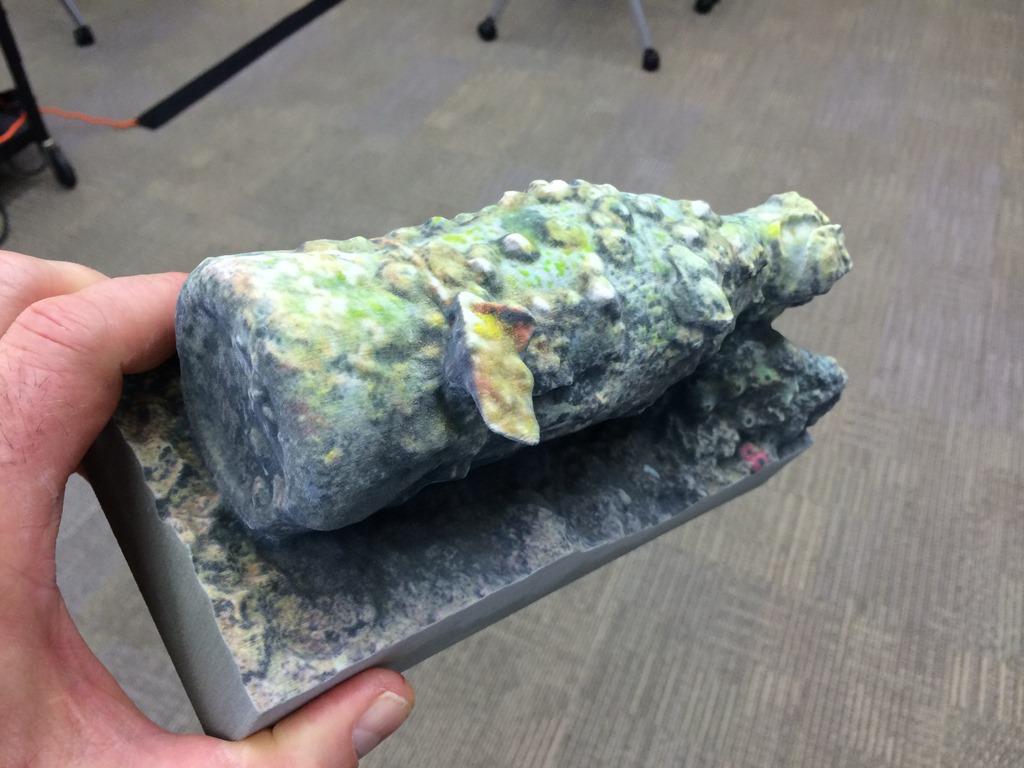On December 7, 1941 Japanese aircraft dropped the bombs that would sink the USS Arizona in Pearl Harbor, killing 1,177 of the officers and crewmen aboard. What could not be salvaged by the Navy remains submerged in the waters where she sank, and the harbor acts as a graveyard for the bodies of over 1,100 sailors and marines who lost their lives when she was destroyed. In 1962 a memorial was built that straddles the hull of the wreckage and includes a marble wall, upon which the names of the dead have been inscribed, along with a dedication:
“To the memory of the gallant men here entombed and their shipmates who gave their lives in action on 7 December 1941, on the U.S.S. Arizona.”
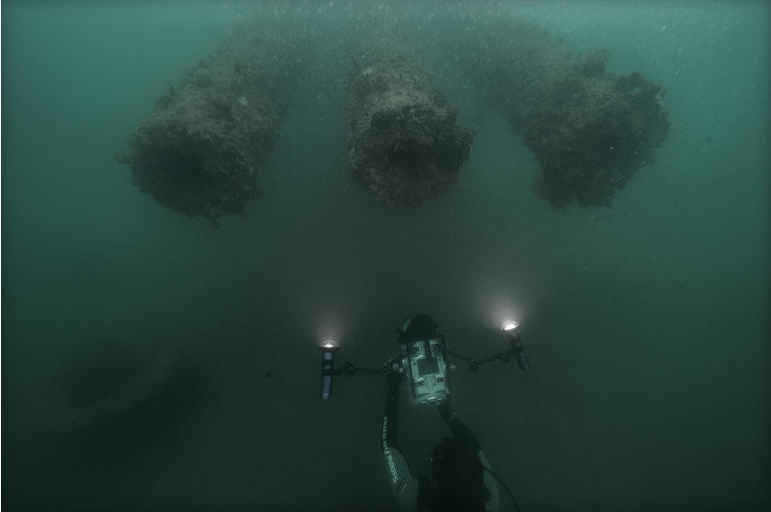 The wreckage of the ship has long been a source of great interest for historians, divers, veterans, and the general public. Like all shipwrecks, it holds an air of mystery because of the way it captures a historical moment. The dramatic way in which the ship became part of the human drama has ensured its place in the collective imagination and in the cultural memory of the nation. Like the Roman ruins or the temples at Angkor Wat, the carcass of the USS Arizona is intriguing because, despite its destruction, it was not erased.
The wreckage of the ship has long been a source of great interest for historians, divers, veterans, and the general public. Like all shipwrecks, it holds an air of mystery because of the way it captures a historical moment. The dramatic way in which the ship became part of the human drama has ensured its place in the collective imagination and in the cultural memory of the nation. Like the Roman ruins or the temples at Angkor Wat, the carcass of the USS Arizona is intriguing because, despite its destruction, it was not erased.
The technologies for underwater exploration have brought us closer than ever to these sunken architectures, and we are beginning to see the Titanic and other famous wrecks in great detail. The US National Park Service, in conjunction with Autodesk, is working to bring us closer than ever to experiencing these places by letting us touch them.
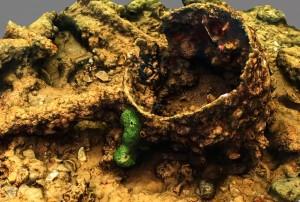 Speaking with CNET earlier this year, Pete Kelsey, Autodesk Strategic Projects initiative explained the scope of the project:
Speaking with CNET earlier this year, Pete Kelsey, Autodesk Strategic Projects initiative explained the scope of the project:
“Technologically, this project is unprecedented. Never before have so many different types of data been brought together to create an intelligent, high resolution, highly detailed model that can used for so many different purposes. This project combined terrestrial laser scanning, SubSea LiDAR, SONAR, and Autodesk’s photogrammetry technology to capture the existing conditions of the ship and create a very accurate virtual model.”
Two objects in particular captured the interest of diver Shaan Hurley; a coke bottle and a cooking pot. These particular artifacts spoke eloquently of the human presence that made the ship more than a piece of machinery. Hurley recounted his experience capturing the  images:
images:
“[It was] easier said than done and definitely physically demanding capturing hundreds of photos in an orbiting sequence [while] exercising good buoyancy and control. It was truly exhausting work and many of us found ourselves, when resting on the dock, falling asleep almost instantly after surfacing from a dive and doing this over 14 hours a day.”
The team spent 15 days in the field capturing the data required to complete the scan (compare this to the 90 days required for a similar data gathering expedition in 1983). Hurley and his colleague Craig Barr used Autodesk Mudbox to finalize the models. When they saw the final products, they wanted the models to be 3D printed so that people could hold them. Imagine being able to pick up and closely examine a replica of something that you would never be able to see yourself, as it is locked away on the bottom of the harbor. Hurley and Barr connected with Whiteclouds, a Utah based 3D printing company and talked with its CEO Jerry Ropelato who immediately recognized the value of the project and agreed to print both artifacts in color.
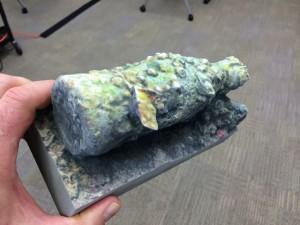 Printing the 959 layers to create the coke bottle at full scale and in color, took 5 hours and 24 minutes and the cooking pot, which was printed at 1/3 scale with 1,028 layers, took slightly over 6 hours to complete on the ProJet 660Pro. Kerry Parker, Whiteclouds’ VP of Business Development shared some of the exciting potential revealed through this project:
Printing the 959 layers to create the coke bottle at full scale and in color, took 5 hours and 24 minutes and the cooking pot, which was printed at 1/3 scale with 1,028 layers, took slightly over 6 hours to complete on the ProJet 660Pro. Kerry Parker, Whiteclouds’ VP of Business Development shared some of the exciting potential revealed through this project:
“We are continually amazed by the applications of 3D printing and now we can add underwater exploration to the list. If you can imagine a classroom of students that will never have the opportunity to dive down and experience the remnants of the Arizona. Now, through 3D scanning and printing, it would be possible for them, or anyone, to hold and study a replicated artifact…There’s something that’s communicated through the physical objects that you don’t get with photographs or video.”
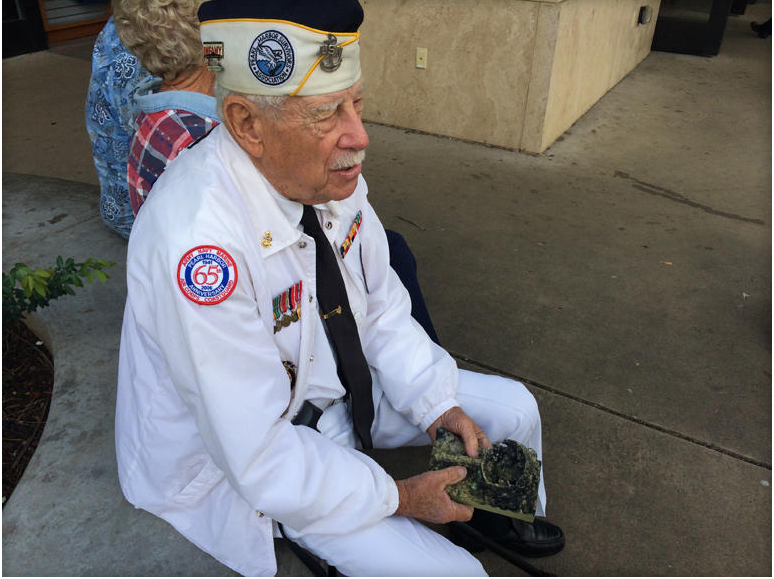 The team had a chance to present the cooking pot to Don Stratton, a survivor of the attack. For him, being able to hold these objects, brought to the surface through 3D printing, also brought to the surface his own submerged emotions. As the flag was raised, he and others shed silent tears for those who were lost. Stratton shared his memories in advice he gave to a US Navy commander who was present with some of his men: “You take care of those young men.”
The team had a chance to present the cooking pot to Don Stratton, a survivor of the attack. For him, being able to hold these objects, brought to the surface through 3D printing, also brought to the surface his own submerged emotions. As the flag was raised, he and others shed silent tears for those who were lost. Stratton shared his memories in advice he gave to a US Navy commander who was present with some of his men: “You take care of those young men.”
The physical presence of what lies before the water may be silent, but it is not mute. The 3D models of the ship and its artifacts will become all the more important as the saltwater takes its toll on the remains of the boat, and it slowly, but surely, decays.
Discuss this tremendous achievement in the USS Arizona 3D printed artifacts forum thread on 3DPB.com
Subscribe to Our Email Newsletter
Stay up-to-date on all the latest news from the 3D printing industry and receive information and offers from third party vendors.
Print Services
Upload your 3D Models and get them printed quickly and efficiently.
You May Also Like
Metal Powder Supplier Elementum 3D Added to $46B Air Force Contract
Elementum 3D, a Colorado-based developer and supplier of metal powders used in additive manufacturing (AM), announced that the company has been added to the vendors list in the fourth on-ramp...
Ursa Major Lands $28.6M AFRL Deal for 3D Printed Draper Engine Flight Demo
The US Air Force Research Laboratory’s (AFRL’s) Rocket Propulsion Division at Edwards Air Force Base has awarded a $28.6 million contract to Ursa Major for follow-on work related to the...
3D Printing Financials: Rocket Lab’s Record-Breaking Year and Over 20 Launches Coming in 2025
Rocket Lab (Nasdaq: RKLB) closed 2024 with its best year yet. The company launched more rockets, signed more contracts, and expanded deeper into spacecraft and satellite production than ever before....
US Air Force Taps Beehive to Study 3D Printed Jet Engines
Propulsion 3D printing firm Beehive Industries secured a contract from the U.S. Air Force Life Cycle Management Center through SOSSEC. SOSSEC is a company that manages Other Transactions Authority (OTA)...



